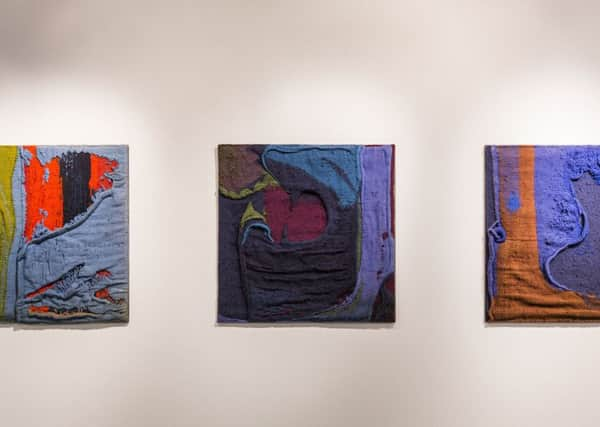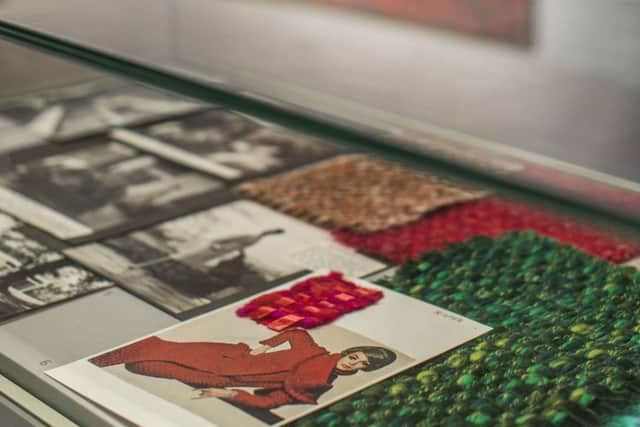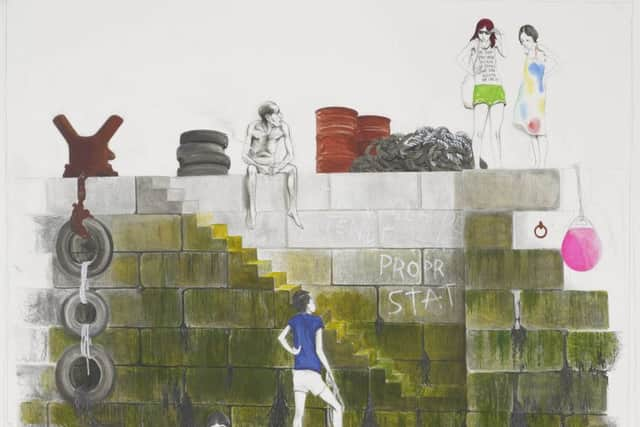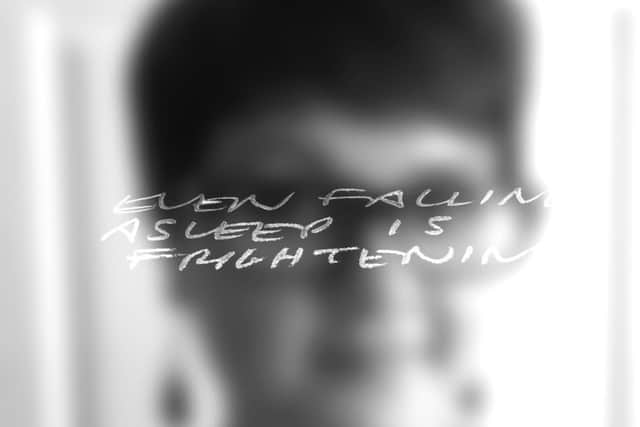Art reviews: Thresholds | Bernat Klein | Charles Avery | Derek Michael Besant


Thresholds
Edinburgh Sculpture Workshop *****
Bernat Klein: A Life In Colour


Dovecot Gallery, Edinburgh ****
Charles Avery: The People And Things of Onomatopoeia
Ingleby Gallery, Edinburgh ***
In Other Words... Derek Michael Besant


Edinburgh Printmakers ****
Postmodernism was born of the belief that Modernism was exhausted, it could evolve no further and artists would have to look elsewhere for inspiration. Not knowing where to turn, they have too often simply looked within themselves and, doing so, mostly haven’t found much of interest. Toby Paterson, however, circumvented this apparent Postmodern impasse to find an enduring and still relevant sense of purpose in the formality and utopian idealism of early Modernist architecture. This led him in turn to reconsider Constructivism and the rich legacy of abstract art driven by ambitious ideals that grew out of it. In consequence, when so much of the work of his contemporaries seems stymied by self-absorption, his has a fresh and vital sense of purpose and social engagement. His most recent project, a set of seven reliefs, one for each of the seven Maggie’s Cancer Caring Centres in Scotland, demonstrates this most eloquently. The seven reliefs with some supporting material are currently on view at the Scottish Sculpture Workshop. (This small, but lovely show is also an opportunity to see some dramatic new developments at the Sculpture Workshop – the main addition is a big square courtyard for sculpture and the small gallery space housing this exhibition.)
The purpose of the Maggie’s Centres, all adjacent to major NHS hospitals, is to provide comfort and refuge from the impersonal world of the hospital for people affected by cancer. The project was begun by Maggie Keswick Jencks after she herself was diagnosed with cancer. Profoundly affected by the chilly, dehumanising environment of the hospital in which she had to come to terms with her own fate, she determined to create places where people in her situation could retreat to recover a sense of their humanity. “Above all what matters is not to lose the joy of living in the fear of dying,” she declared. The key to this was to be in humane architecture and after her death, the project was taken forward by her husband, Charles Jencks, and world-class building is the signature of the Maggie’s Centres. In the words of Sandy Nairne, chairman of the Maggie’s Art Group, however, “Art within Maggie’s has developed more idiosyncratically.”
Advertisement
Hide AdThere have been important gifts and bequests of art, but of their nature these are not integrated with the architecture. Toby Paterson’s project is an important step towards rectifying this. It is the product of a careful study of the seven buildings and the way they work. To restore a sense of self, they are geared to the individual first of all, although their role as social spaces is also essential. This stress on the personal is reflected in the intimate scale of the reliefs. Paterson has also called them ‘Thresholds’, referring to the moment of entering one of the centres, perhaps for the first time with the awful burden of a grim diagnosis. He and his curator, Judith Winter, explain: “By focusing on this brief moment of unease... we both became aware of this liminal space (the threshold) and the transition from anonymous prescribed systems to a space for the individual.”


Made of small, rectangular slabs of solid aluminium, the largest dimension of any of the reliefs is less than a foot. Thus they are truly private in scale, but they are also gently commanding, inviting you to explore their complexities. The blocks are set at right angles, either to the wall behind or to each other with the boundaries of the composition open all round, not closed. Thus they offer a whole variety of different depths, of light and shade and of open and enclosed spaces. The soft, silvery surface of the metal both reflects the light and seems to absorb it. Some surfaces are coloured, but the soft colour either precisely matches the tone of the shadows, or, if darker, enhances and deepens them. Each composition also results from a dialogue with the building for which it is destined. All the compositions, however, at the same time invite you into their complexity and open out towards the surrounding space. Paterson acknowledges the inspiration of the highly formal art of Mary Martin, but the visual language he has developed really looks right back to Mondrian’s intuitive visual spaces whose formal structure, far from being a limitation, is itself a threshold, an opening for the imagination. There is however nothing remotely derivative about these exquisite works. Defying the negativity of Postmodernism, in Paterson’s hands this Modernist language has enduring vitality. More importantly, the beauty and the still, small voice of these Thresholds will, I am sure, help to remind those for whom they are intended of the joy of living.
Bernat Klein belonged to an older generation for whom faith in Modernism was not yet assailed by doubt. A painter and textile designer, he nevertheless also found a creative route that led him beyond any sense there might have been of its imminent exhaustion. Born in Yugoslavia, Klein settled in Galashiels where, through a remarkable symbiosis, his painting informed a radical approach to textile design. The Dovecot Tapestry Workshop had a long relationship with him, epitomised in a group of ten tapestries made from his paintings back in the early Seventies. Five of these are on view at Dovecot. They are striking, but what is really intriguing is the close relationship of his design to his painting that the exhibition reveals. His paintings are close to the painterly abstraction of the School of Paris and in the early Sixties he was making rich, abstract pictures out of small blocks of rich, impasted colour. He then translated the patterns this made directly into chunky tweeds, where the weaving exactly echoes his brush marks. Used by some of the leading fashion designers, these woven fabrics became a hallmark of the period. He also translated his paintings directly onto printed fabrics which were used in shirts and scarves with equal success.
Charles Avery at Ingleby is, I am afraid, one of those artists for whom the apparent crisis of Postmodernism has led to a stultifying turn into himself. “When I was a child, I spake as a child, I understood as a child, I thought as a child: but when I became a man, I put away childish things,” wrote St Paul. One common childish thing that I am sure most of us put away around the age of ten or 11 is the creation of an imaginary world where, as its creator, the child is in charge. Avery however is now a grown man in his forties, but he is still creating his childish world. I am afraid I find the laboured drawings in which he elaborates the details of this glum and unattractive imaginary place deeply dispiriting. His energy and application are remarkable, as is the sheer scale of what he has done. Nevertheless, it does seem strange that he is celebrated for his drawing when it rises so little above the ordinary.
Finally Edinburgh Printmakers is moving from Union Street to Castle Mill Works in Fountainbridge. To mark the planned move they have commissioned In Other Words from Canadian artist, Derek Michael Besant. Writing from outside, he invited people from the old and new locations of the workshop to submit portraits of themselves and also answer five, fairly personal questions about their lives and their dreams. Deliberately out of focus, seven of these fuzzy portraits have been installed on a huge scale on the outside of the Workshop’s future premises. In the exhibition itself, fragments of the answers Besant received are written on the portraits. Some of are quite unsettling and so, although it doesn’t sound very promising, the overall effect of these ghostly faces and disembodied words is strangely spooky.
• Thresholds until 29 August; Bernat Klein until 26 September; Charles Avery until 30 August; Derek Michael Besant until 5 September, www.edinburghartfestival.com